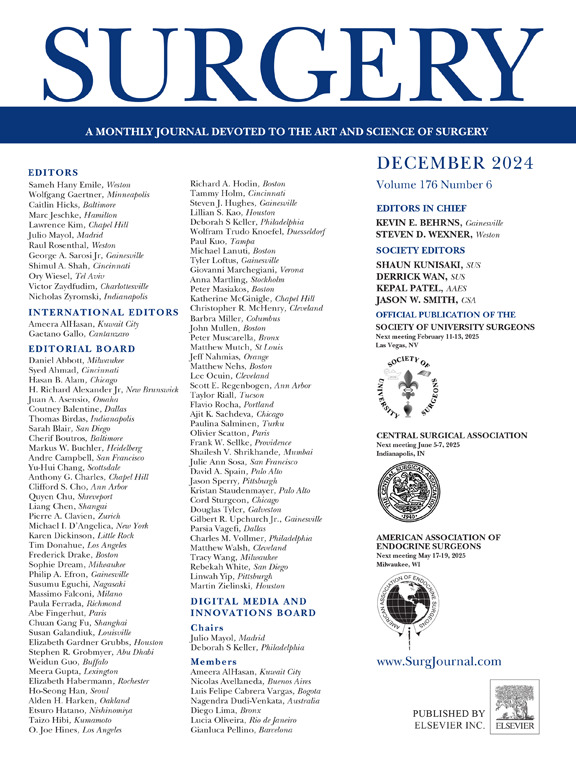Outcomes of near-infrared fluorescence guided colonic interposition for corrosive esophageal stricture
IF 3.2
2区 医学
Q1 SURGERY
引用次数: 0
Abstract
Introduction
Colonic interposition is the most commonly performed surgery for high corrosive esophageal or combined esophagogastric strictures. Here, we present the outcomes of colonic interposition using a modified right colonic graft and the utility of indocyanine green–guided fluorescence imaging.
Methods
We retrospectively reviewed the medical records of 30 patients with corrosive esophageal strictures who underwent colon interposition surgery between July 2017 and December 2023. The ascending colon, without including the ileocecal valve, and with the transverse colon, which was determined by the ascending branch of the left colic artery in an isoperistaltic fashion, was used in all patients. Vascularity was assessed after clamping the marginal and middle colic arteries using near-infrared fluorescence imaging, and any changes in management based on fluorescence imaging were noted. Short- and long-term outcomes also were analyzed.
Results
Among the 30 patients, 20 were male, with a median age of 32 (20–59) years. Only 1 patient (3.3%) had conduit necrosis and underwent re-exploration with necrotic segment removal with esophagostomy. Among the 4 patients who had abdominal anastomotic leaks, 2 were managed conservatively and 2 underwent re-exploration. Twenty-five patients (83.3%) had a median weight gain of 5 (3–25) kg. Five patients (16.6%) had anastomotic stricture, of whom 4 were successfully managed with endoscopic dilatation. The median EuroQol 5-Dimension 5-level health scale score was 90 (70–100).
Conclusion
Indocyanine green–guided fluorescence is a useful adjunct during colonic interposition and a modified right colonic graft provides a good quality of life.
近红外荧光引导结肠介入治疗腐蚀性食管狭窄的效果
结肠介入是高腐蚀性食管或合并食管胃狭窄最常用的手术。在这里,我们介绍了使用改良的右结肠移植物和吲哚菁绿色引导荧光成像的结肠介入的结果。方法回顾性分析2017年7月至2023年12月间行结肠介入手术的30例腐蚀性食管狭窄患者的病历。所有患者均采用升结肠,不包括回盲瓣,而横结肠由左结肠动脉升支以等蠕动方式确定。使用近红外荧光成像技术夹紧结肠边缘动脉和中动脉后评估血管状况,并记录荧光成像治疗的任何变化。对短期和长期结果也进行了分析。结果30例患者中,男性20例,中位年龄32岁(20 ~ 59岁)。只有1例(3.3%)患者发生导管坏死,并再次探查坏死段切除食管造口术。腹吻合口瘘4例,保守治疗2例,再次探查2例。25例患者(83.3%)中位体重增加5 (3-25)kg。吻合口狭窄5例(16.6%),经内镜扩张术成功处理4例。EuroQol 5维5级健康量表得分中位数为90分(70-100分)。结论吲哚菁绿色荧光在结肠介入术中是一种有用的辅助手段,改良的右结肠移植物可提供良好的生活质量。
本文章由计算机程序翻译,如有差异,请以英文原文为准。
求助全文
约1分钟内获得全文
求助全文
来源期刊

Surgery
医学-外科
CiteScore
5.40
自引率
5.30%
发文量
687
审稿时长
64 days
期刊介绍:
For 66 years, Surgery has published practical, authoritative information about procedures, clinical advances, and major trends shaping general surgery. Each issue features original scientific contributions and clinical reports. Peer-reviewed articles cover topics in oncology, trauma, gastrointestinal, vascular, and transplantation surgery. The journal also publishes papers from the meetings of its sponsoring societies, the Society of University Surgeons, the Central Surgical Association, and the American Association of Endocrine Surgeons.
 求助内容:
求助内容: 应助结果提醒方式:
应助结果提醒方式:


